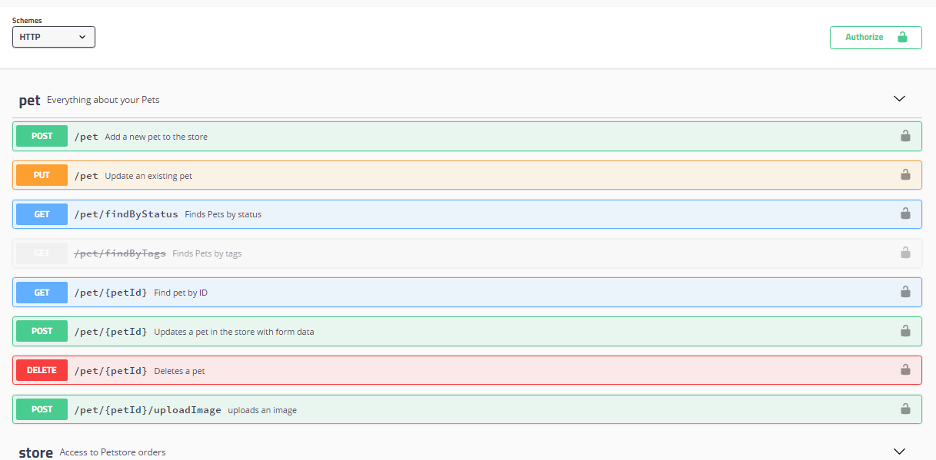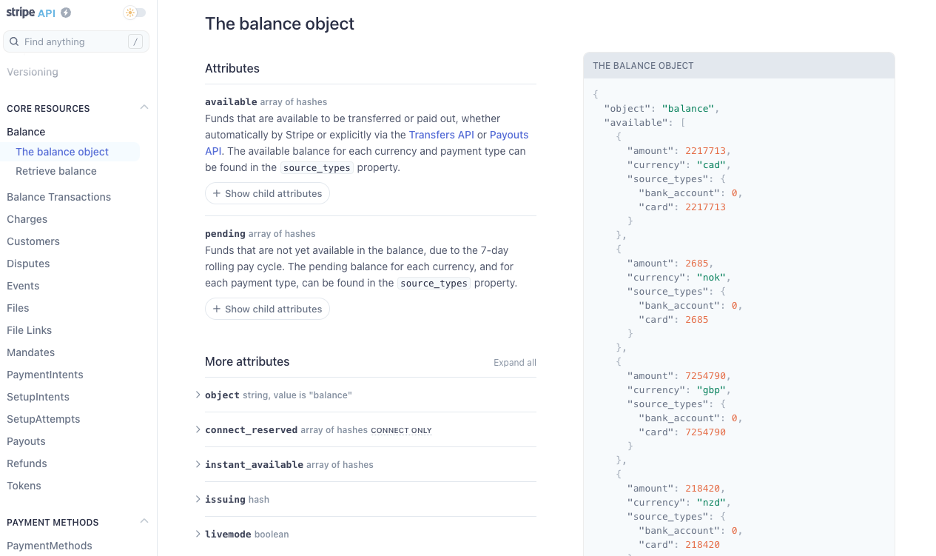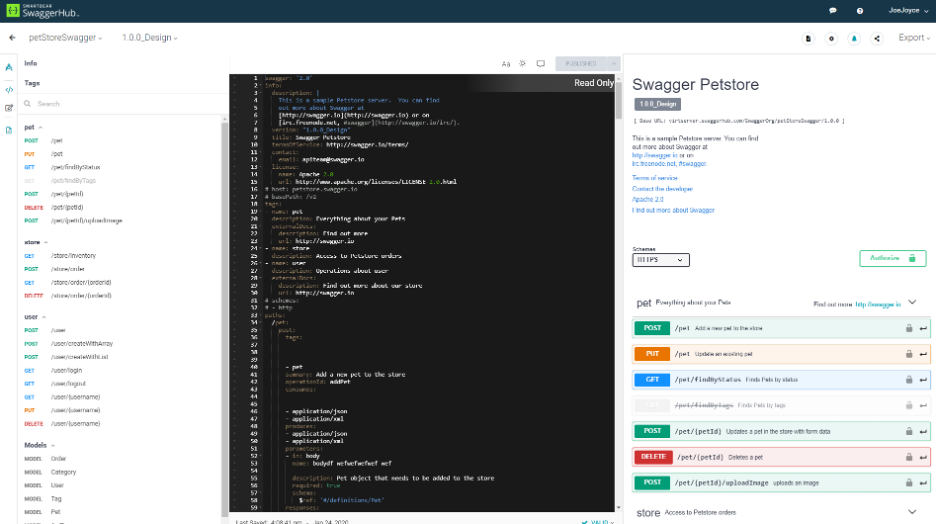How to Create Exceptional API Documentation
As software becomes more specialized, APIs are more and more vital to driving innovation. And API documentation is essential for shared understanding.
This article discusses why it’s essential, and how to create effective documentation so your end users will be more inclined to use your API over others.
What Is API Documentation?
API documentation is a map that guides any developers who want to integrate with your software. With thorough API documentation, developers can quickly understand the functionality of your API, responses to expect, and errors that could occur. A clear understanding of these factors is what makes developers more likely to integrate your API into their applications.
 SwaggerHub makes it easy to generate API documentation and keep it updated programmatically. Source: SmartBear
SwaggerHub makes it easy to generate API documentation and keep it updated programmatically. Source: SmartBear Most API documentation lives on a website or dedicated developer portal. You can password-protect the URL path if the documentation is internal.
But, if your documentation is external, it's a good idea to make the content as accessible as possible. Many developers prefer a self-service approach, browsing API docs and getting up-and-running without a human touch point.
Starting with a Reference
Most API documentation begins with a reference as a base requirement.
When building an application, developers must ensure that a partner API provides the functionality they need. API references provide a structured overview of the API’s capabilities and details about each endpoint and what kinds of data and response formats they can expect.
For instance, SwaggerUI provides an accessible API reference showing each endpoint, available parameters, example responses, and status codes. And as a bonus, SwaggerUI docs look consistent across organizations, so developers may find them more familiar than custom solutions.
 Stripe offers one of the best examples of functional API documentation. Source: Stripe
Stripe offers one of the best examples of functional API documentation. Source: Stripe Stripe provides one of the best API reference implementations. In addition to detailed explanations of each endpoint, the documentation has a dropdown providing a practical example in various programming languages and platforms, ranging from Curl to Python to Node.js. In this way, developers can easily understand how to implement it.
Beyond Basic Documentation
API documentation should begin with a solid reference, but that's only the start of creating an excellent developer experience. You can set yourself apart from the competition by providing up-to-date guides and tutorials targeting popular frameworks or done-for-you API clients that make it even easier to consume your API.
Guides & Tutorials
Guides and tutorials are an excellent way to set your API apart from the competition. Developers often choose the path of least resistance, and providing an up-to-date tutorial helps them ship faster. However, it's imperative to keep these guides up to date to avoid complaints from developers using the guide on newer languages or frameworks.
The most effective guides and tutorials target the most popular tech stacks. For example, a payment or authentication API may provide guides showing how to get set up using React, Svelte, or other popular JavaScript frameworks. You might also target niche frameworks, such as Ruby on Rails or Django, to capture specific audiences.
In addition to these high-level guides, API providers may want to provide guides to showcase how to achieve particular outcomes via interaction with the API endpoints. For example, using the Stripe example, a business may want to know how to process a refund that requires hitting multiple API endpoints.
API Clients & SDKs
API clients and SDKs are another popular way to create an excellent user experience. Rather than forcing developers to consume APIs directly via a REST HTTP, you can provide a helpful library in their target language or framework, natively exposing the methods and functionality they need.
 Stripe offers a client SDK for iOS that simplifies implementation. Source: Stripe
Stripe offers a client SDK for iOS that simplifies implementation. Source: Stripe For example, Stripe provides an iOS SDK that exposes out-of-the-box components to collect users' payment details. For example, the mobile payment element (seen above) is a prebuilt payment UI that you can use in the checkout of your iOS app with the PaymentSheet class. As a result, developers don't have to worry about any custom implementation.
Learn more about financial service strategies here:
API Strategies for Digital Success in Financial Services - Expert Roundtable
BIAN + SmartBear: Enabling Open Banking Adoption and FinTech Innovation
API Documentation Challenges
API documentation can become unwieldy . Growing applications lead to expansive APIs, creating a tapestry of commands, functionalities, and potential errors. And a document initially intended as a manual can quickly morph into a labyrinth that's difficult to navigate.
In addition to keeping up with new additions, it takes effort to ensure the accuracy of existing APIs. Outdated or incomplete documentation can lead to frustration. And if you have multiple versions of an API, maintaining up-to-date documentation across the board can quickly become overwhelming.
Finally, enforcing consistency across APIs becomes a challenge over time. If API development occurs in silos, the syntax and functionality can quickly become inconsistent, leading to a poor developer experience. For example, a "paymentId" in one API might be a "PaymentID" in another API, leading to frustrating mistakes and confusion
How SwaggerHub Can Help
SwaggerHub offers a solution to these challenges, making it easy to create and maintain accurate API documentation efficiently. With a design-first approach, teams can define an API's structure and expected behavior before writing any code, ensuring clarity and consistency even if multiple teams work on different APIs.
 SwaggerHub’s editor makes it easy to organize your API. Source: SmartBear
SwaggerHub’s editor makes it easy to organize your API. Source: SmartBear In addition, SwaggerHub automates several parts of the documentation process. When an API definition is updated, the documentation is automatically regenerated to reflect these changes. The platform even provides tools for managing API versions, enabling developers to transition between versions seamlessly.
SwaggerHub also goes beyond API references to automatically generate client and server SDKs. That way, you can provide a quick template for developers to get up and running quickly. And internally, you can create server stubs to test APIs and set the stage for development after completing the design phase.
And finally, SwaggerHub simplifies communication across large teams. The platform provides smart error feedback and syntax autocomplete within your editor, and you can create embedded API design rules that enforce standards in real time. There are even domains for cataloging and reusing common OAS syntax across multiple APIs.
The Bottom Line: Good Documentation Is Essential
Documentation is essential to promote API adoption. By lowering the knowledge barrier, you make it easier for developers to understand and implement your API.
While a reference is a great starting point, having guides, tutorials, and client SDKs can make it even easier for developers to implement an API. And it sets you apart from the competition.
Get started with SwaggerHub for free!